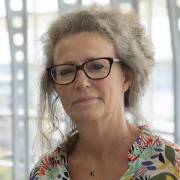
Copyright : Laboratoire LEMAR- 2018
Acoustics is a method of observing the marine environment using the properties of wave propagation in water. Using the sounders, the teams can visualize the distribution of the various organisms in the water column.
The ultrasounds emitted by the sounders are reflected as soon as there is a change of density in the environment, as between sea water and an obstacle like the bottom, the surface, a fish, a bubble, crustaceans... Each element thus encountered, whose echo is measured, has a characteristic frequency signature. The use of multi-frequential systems and very recently of wide band systems, makes it possible to classify the organisms in groups such as: fish with gas bladder, crustaceans, gelatinous,...
This approach provides information on all biotic components of the environment, from zooplankton to top predators. It can also provide information on physical structures (fronts, internal waves, etc.). It is thus possible to determine the spatial distribution of the various components of the ecosystem and to explore their interactions with environmental parameters. This versatility allows the platform to participate in numerous multidisciplinary research projects.
The active acoustics platform aims to
The platform has 4 engineers from IRD and works on several international sites for which it collaborates closely with researchers from LEMAR and other UMRs that carry the projects. Notably West Africa, in particular Senegal, North-East Brazil, the Pacific (New Caledonia, Wallis and Futuna), or the Indian Ocean. Although active acoustics are widely used in marine environments, they can be applied in all aquatic environments. Missions have been carried out in continental waters, such as the Sine Saloum estuary in Senegal or Lake Titicaca in Bolivia.
The sounders work with a transmitter/receiver unit connected to submerged transducers. During survey missions, the teams can come with their mobile sounders or the sounders are part of the on-board scientific equipment on certain research vessels (Thalassa, Antea, Alis, Europe). The most commonly used equipment, mobile or onboard, are the Simrad EK80 multi-frequency sounders, each frequency can be used in narrowband or wideband.
Acoustic recordings are supplemented with video or biological sampling to determine which species are detected. In addition, environmental parameters (temperature, salinity, oxygen, fluorescence, etc.) are regularly measured to study the interactions between physics and biology.

 Climate Rooms
Scroll to top
Climate Rooms
Scroll to top